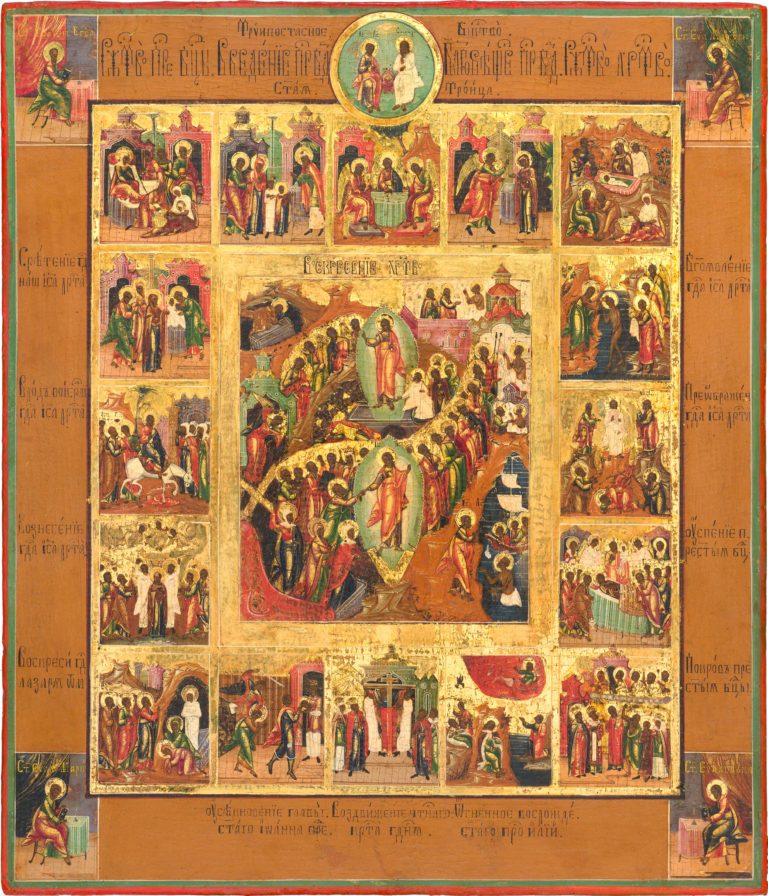The Resurrection—the Descent into Hell, with Church Feasts, the Holy Trinity, and the Four Evangelists
Antique Russian icon. Second half of the 19th century. Palekh.
Size: 36 х 30.5 х 2.8 cm
Wood (three panels), channels from two incut support boards (now lost), absence of an incut centerpiece, the underlying layer of canvas not visible, gesso, tempera, gold.
The author’s paintwork is in overall good condition. Slight chafing and small fallouts of the paint layer.
The reverse of the antique icon panel bears a stamp mark: Private/ property/ A.G.
Contact us

The Resurrection—the Descent into Hell, with Church Feasts, the Holy Trinity, and the Four Evangelists
Diagram of the border scenes:
- The Nativity of the Mother of God;
- The Entrance of the Mother of God into the Temple;
- The Old Testament Trinity;
- The Annunciation;
- The Nativity of Christ;
- Candlemas (The Meeting of Christ in the Temple);
- The Theophany (The Baptism of Christ);
- The Entrance into Jerusalem;
- The Transfiguration;
- The Ascension;
- The Dormition of the Mother of God;
- The Raising of Lazarus;
- The Beheading of John the Baptist;
- The Elevation of the Holy Cross;
- The Fiery Ascent of the Prophet Elias;
- The Pokrov (Feast of the Protective Veil of the Mother of God);
- The Holy Trinity (The Enthronement);
- The Evangelist John the Theologian;
- The Evangelist Matthew;
- The Evangelist Mark;
- The Evangelist Luke.
The theme of the Resurrection of Christ is amongst the most popular subjects in religious icon art. Small-sized hand-painted icons, similar to the given one, were usually placed on the analoion during Church services or kept at home for private prayer. According to the established tradition, the centerpiece of such Eastern Orthodox icons is dedicated to a detailed version of the Resurrection – the Harrowing of Hades, surrounded by sixteen border scenes that bear the depictions of the main Church Feasts (that is why these religious icon paintings are known as “polnitsy” or “full cycle icons”). The many-tiered composition traditionally includes the Rising from the Tomb. The described variation of the Resurrection was shaped in 16th century Russia under the influence of Western European etchings and the translation of the apocryphal Gospel of Nicodemus, which was included into The Great Almanac of Metropolitan Macarius. By the middle of the 17th century, the iconographic form became more complex and enriched by new events, which followed the Resurrection and predated the Ascension of Christ. The Rising from the Tomb scene takes its place in the upper part of the antique icon composition, and the Harrowing of Hades is depicted directly below. Thus, the composition is built on two centers placed along a single axis. This iconographic variation was shaped in Moscow but was especially popular in the Volga Region (in Yaroslavl and Kostroma). In the second half of the 18th century, it was taken up by Palekh religious icon painters – and ever since then, it occupies the center of polnitsy icons. The exterior frame of 16 border scenes traditionally contains depictions of Church Feasts, starting with the Nativity of the Mother of God, which begins the yearly liturgical cycle. The lower part of the frame contains four additional scenes, typical for such hand-painted icons, which were introduced by Palekh iconographers in the early 19th century: the Beheading of John the Baptist, the Elevation of the Holy Cross, the Fiery Ascent of the Prophet Elias, and the Pokrov of the Mother of God. The corners of the given antique Russian icon bear the depictions of the Four Evangelists: John the Theologian, Matthew, Mark, and Luke.
The production of such miniature, complex compositions was widespread in the Russian icon-painting villages of the Vladimir region in the middle of the 19th century. These works of religious icon art are known for their graphics and yearning for the Old Russian iconographic tradition, which was immensely popular among the Old Believers and also quickly won recognition among the adherents of the official Church. The stylistic traits of this antique Russian icon clearly indicate that it was painted in one of the Palekh’s workshops in the middle of the 19th century.